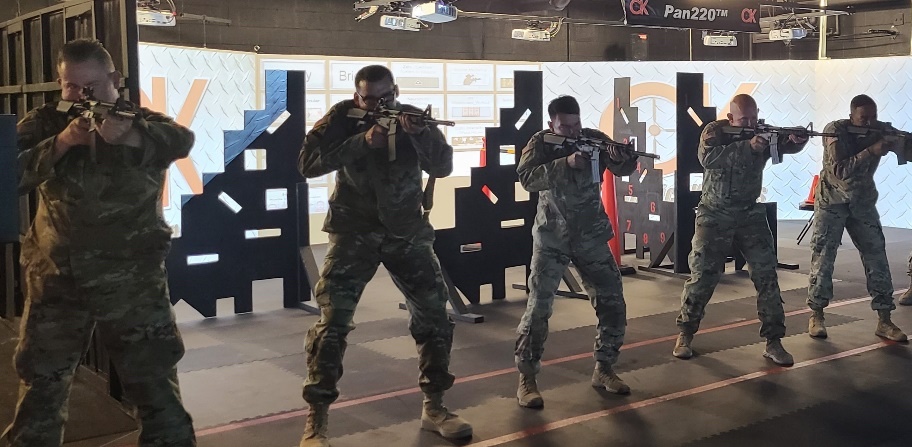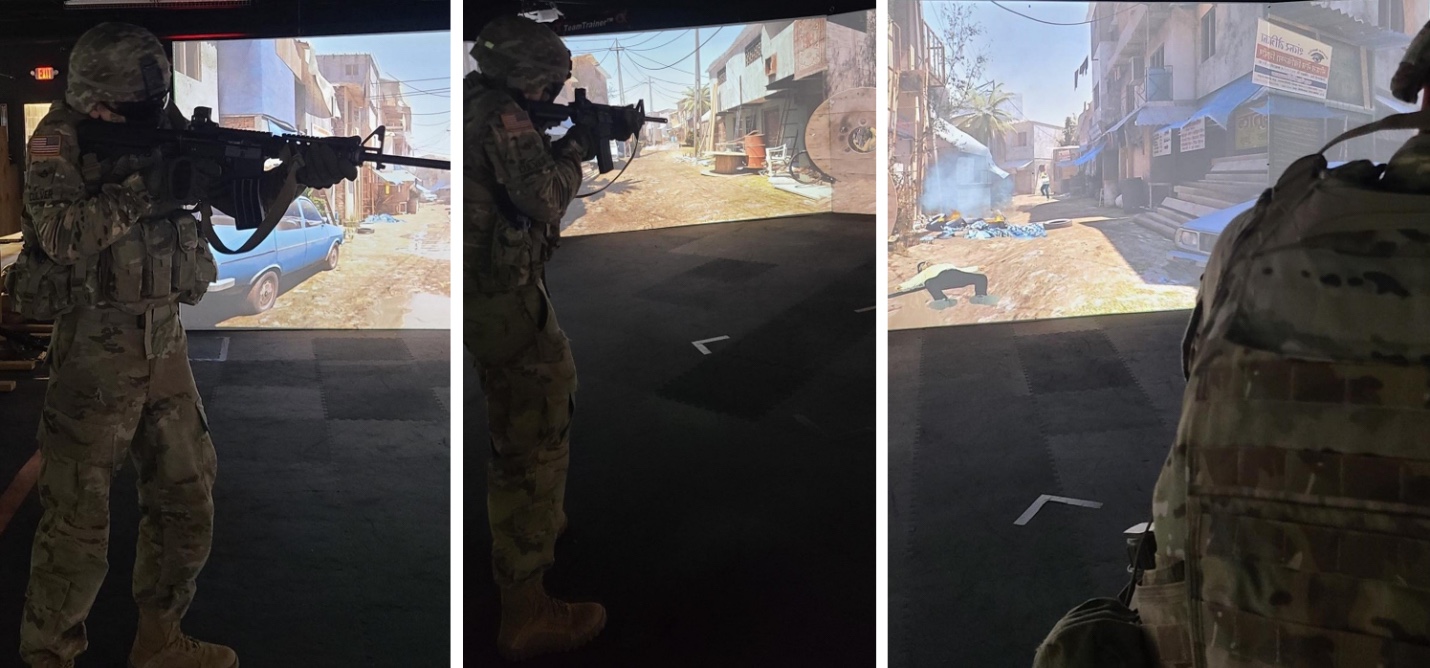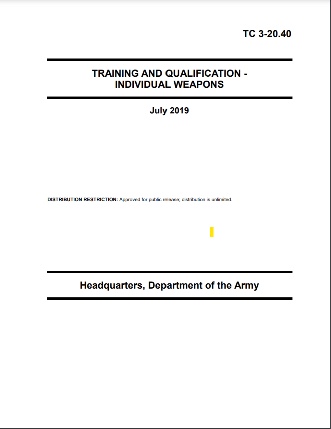Every year thousands of Reserve and National Guard service members from across all forces of Department of Defense (DoD), come to Fort Bliss before deploying. While service members are at Fort Bliss, they execute different levels of training based on individual and unit proficiency, naturally a unit does not execute URM training if they have not qualified with the individual weapon; we, at Task Force Stallion, under 5th AR BDE, see qualification as a pre-requisite for any advanced training. Observer-Coach/Trainers play a crucial role in the units training, as we observe first, then coach and train to give them honest feedback through After-Action Reviews. One of the training events that service members go through at Fort Bliss is the Gunfighter Gymnasium (GfG).

5th AR BDE GfG, OC-Ts, Instructor Trainer Course, Nov 2020: (left to right) SSG Pleinis, SGT Barton, SSG Gomez, SSG Ziegler, SSG Beavers.
5th Brigade has made an Investment in the Service Member and the effect is Revolutionizing Readiness across the Brigade through what is being called the Gunfighter Gym (GfG). This investment is not a material solution, but rather a wholistic Soldier investment in eyes, mind, central nervous system, and body. The gym’s focus is to rapidly guide service members to reach their Peak Human Potential (PHP) in a very short time. By, investing in the service members cognitive decision making under stress, while fighting in a 360-degree environment, we are witnessing, measuring, and analyzing data across multiple units, as our great men and women, are going from Zeroing their rifle in Basic Rifle Marksmanship (BRM), into Urban Rifle Marksmanship (URM) in the GfG, culminating out at the live-fire range; and reaching new personal bests across all qualifications. Thus, creating and confirming a more lethal, faster thinking and reacting service member. The same effect is happening in pistol and automatic weapons training.

The GfG provides service members with opportunities that they rarely see at home station training. Some examples are the new Army Weapons Qualification for the M4 carbine, where service members complete their virtual marksmanship qualification tables (Table II), as outlined in TC 3-20.40, “I attempted this qualification standard once and got 18 or so 3 times, this time, at the range I got 35 out of 40, first time and it seemed so much easier” (SSG, 864th Theater Support Group, Feb 2021). Others are the execution of training packages which include Urban Rifle Marksmanship (URM), Close Quarters Battle (CQB), Team/Squad Battle Drills (with their assigned weapon or Conflict Kinetics Synthetic Weapons) and this Gym can easily add support by fire, call for fire and crew served weapons. The ability to change the environment in the GfG is limitless, which has allowed us to truly focus on the servicemembers needs based on their area of deployment.
During the first 6 months of throughput in the GfG, while under COVID restrictions, exceeded 1 million shots fired, over 3.5 million decisions made, and over 4108 Servicemembers from U.S. Army, Air Force, and Navy having been trained and mobilized. Our gym is being run 24/7 and there have been zero down training hours/days due to equipment malfunctions. The GfG is leveraging video-based roll players, with further capabilities to bring VR/MR and shoot-back capabilities for full mission profiles. They are capturing big data on cognitive, emotional, and physical performance for the life of the service member, that further down the road, we could leverage in the unfortunate event of a TBI or MTBI incident. The ability that the GfG gives us, knowing what a service members PHP was prior to suffering the trauma, can more rapidly map them back to full operational capacity. It is great for the service member and great for the United States of America.
The GfG provides much more realistic training and scenarios, than a live-fire range ever could. In one day, service members can fire over ten times the number of rounds than they would at a live-fire range. Not only that, but they can also switch up scenarios in a matter of minutes and train in different situations and environments. Using the Conflict Kinetics (CK) training methodology is less costly, gives service members more time to sharpen their marksmanship skills, lets them have more repetitions, gives service members more time training because they do not have to worry about how much ammo they are allotted, or how much time they have left on the range based on scheduling or daylight. As stated by a member of the 864th Theater Support Group, “Being scheduled for the gym on the training calendar, allowed us to focus on only this task for the first time in years” (1LT, 864th Theater Support Group, Feb 2021).
After going through the Instructor Training Course provided by CK, having served over 18 years of service to my country and the Army, I improved my lethality, cognitive skills, speed, and accuracy in 5 days of training. With my years of experience, I have not seen a better system, that truly helps the individual service member and units collective training that CK provides through Human Performance. There are over 3200 drills that Soldiers can train on, so the ability to game the system is impossible. With varying scenario’s, Soldiers are trained to react to threats rapidly and in a more lethal manner. All drills have lethality zones built into the target, which takes the shooters actions into account as well as the drills actions, and provide a lethality score per shooter. Another unique advantage to this system that I have seen, is the ability to create a Unit Identifier (UID) that can follow the service member anywhere there is a GfG. This is an area I have not seen before with simulators. My personal UID, if I were to PCS to the 173rd in Italy, as an example, I could see the site tech at the 173rd, give him/her my UID, and in no more than 1 week time frame, my profile and everything I have shot will be in the system at my new duty station. Potentially, if this system were across the Army, we could track a Soldiers shooting career from Basic Training until they exit the Army, what I could have done with that data as a 1SG, would have been limitless! PVT X goes to shoot in the GfG, he is a lethal shooter but that day shoots horribly, this lets me know his mind is somewhere else, and provide focused attention to care for the Soldier through his leaders.
 The GfG has been certified to Army Doctrine standard by DOTD, Maneuver Center of Excellence and has created a training path called the “Principal Path” that has been proven to be more efficient and effective than taking the troops to the live fire range. In a recently published Marine Corps MCOTEA study the GfG was shown to be a “viable substitute for live fire.” As we see it here at 5th Brigade, if we continue to invest in the wholistic training of the service member, how they see, think, react and more, we are delivering highly trained, problem solving, lethal service members in the shortest amount of time for Combatant Commanders within their Theaters of Operation.
The GfG has been certified to Army Doctrine standard by DOTD, Maneuver Center of Excellence and has created a training path called the “Principal Path” that has been proven to be more efficient and effective than taking the troops to the live fire range. In a recently published Marine Corps MCOTEA study the GfG was shown to be a “viable substitute for live fire.” As we see it here at 5th Brigade, if we continue to invest in the wholistic training of the service member, how they see, think, react and more, we are delivering highly trained, problem solving, lethal service members in the shortest amount of time for Combatant Commanders within their Theaters of Operation.
By MSG James S. Sharp, TF Stallion 3-362 IN, 5th AR BDE
MSG James S. Sharp is an Infantryman and has served for 18 years. He joined the Army in 2003 and has been on 7 combat tours, 3 to Iraq and 4 to Afghanistan. He has served most of his time at Fort Drum, but was also in Alaska at Fort Richardson, and was a Drill Sergeant at Fort Benning. MSG Sharp is currently at Fort Bliss were he serves as a Senior OC/T for 3-362 IN, TF Stallion 5th AR BDE. He has been an Master Trainer for the Gun Fighter Gym system for over a year. He is 44 years old and has a wife and two sons.
The views of MSG Sharp are his own personal opinions and do not reflect official DoD policy or endorsement.

